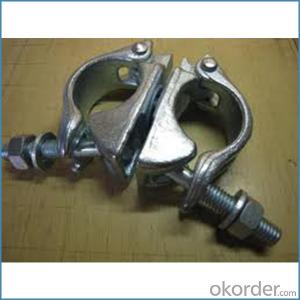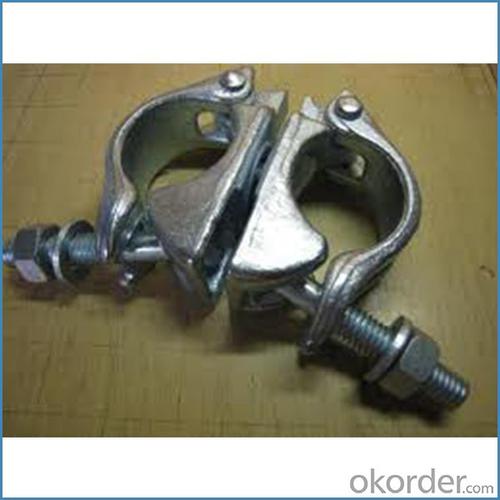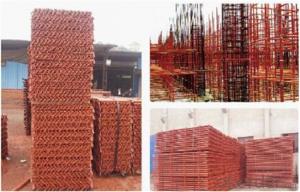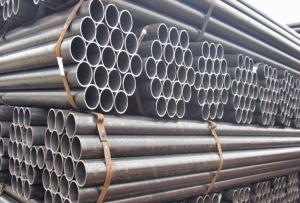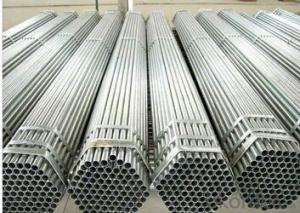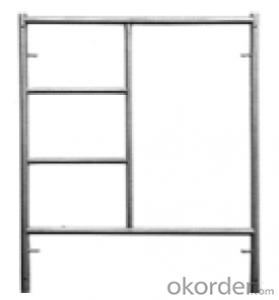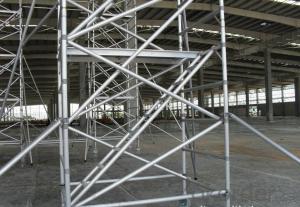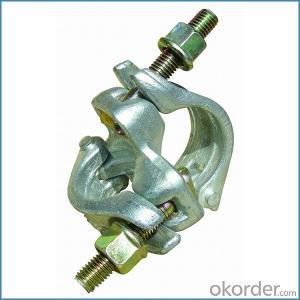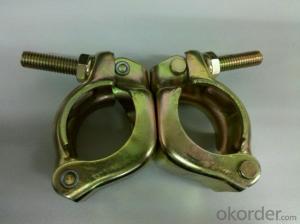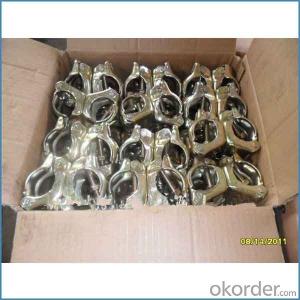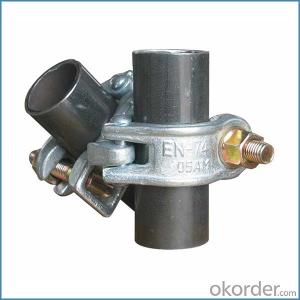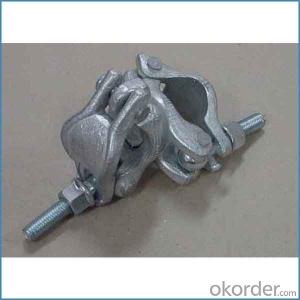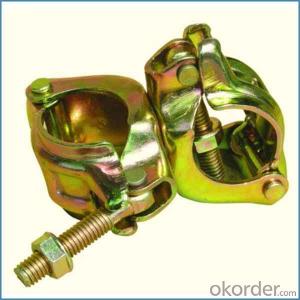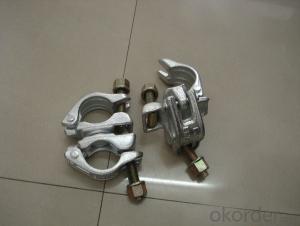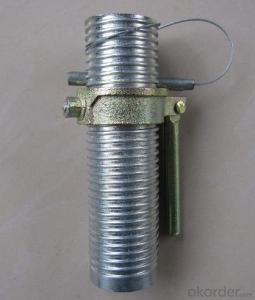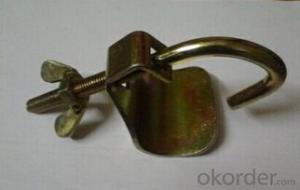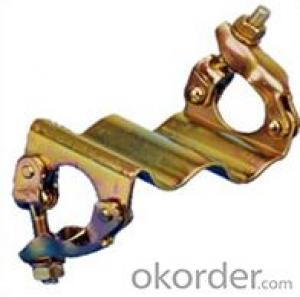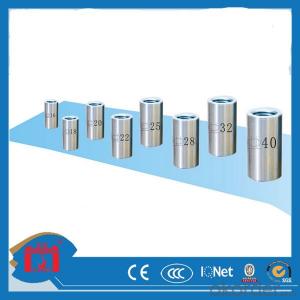Stainless Steel Coupler British Type for Sale
- Loading Port:
- Tianjin
- Payment Terms:
- TT OR LC
- Min Order Qty:
- 1000 kg
- Supply Capability:
- 100000 kg/month
OKorder Service Pledge
OKorder Financial Service
You Might Also Like
Stainless Steel Coupler British Type for Sale
Description
1.The scaffolding coupler is always used to connect the steel pipe as scaffolding system.
2.The often used coupler is swivel coupler and righ angle coupler .
3.We can provide types of scaffolding coupler according to your requirement.
4.Couoler can fix the 48.3mm scaffolding steel pipe tightly and make the whole scaffolding system more steadily.
5.Material:Q235 steel
6.Overall Size:48.3mm*48.3mm
7.Surface Finish: Galvanized/ Painted
8.Standard:BS1139,EN74
9.Package:25pcs/bag
10.Manufactuering as per customer requirements
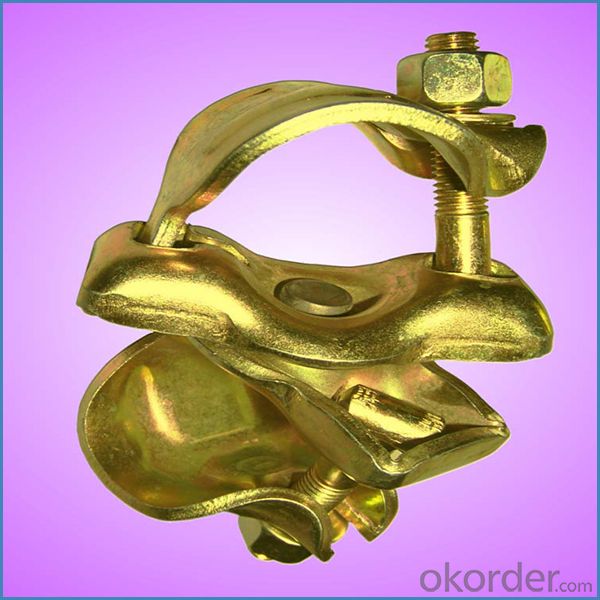
Feature
(1)Excellent Anti-Breaking—Cold Pressed Steel
(2)Outstanding Resistance Deformation
(3)Strong Anti-Dropping Ability
(4)Longtime USe
(5)Qualtity Guaranteed
(6)OEM Service
Photo
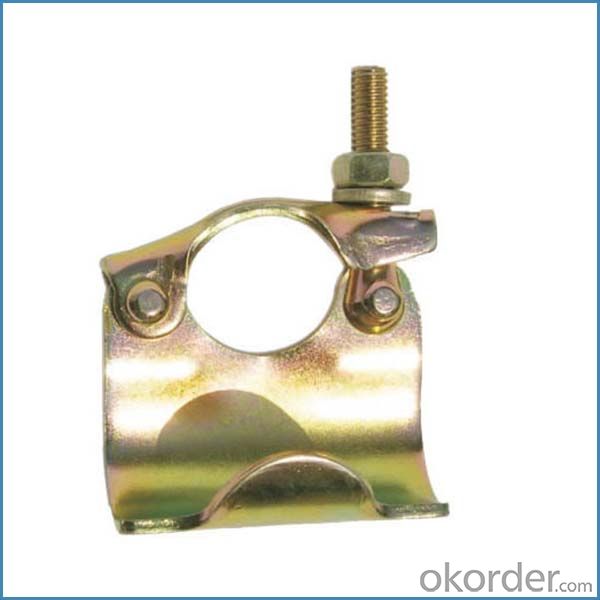
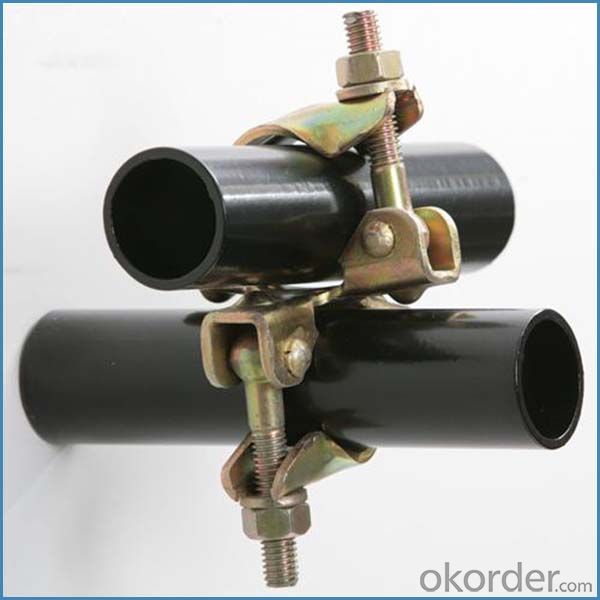
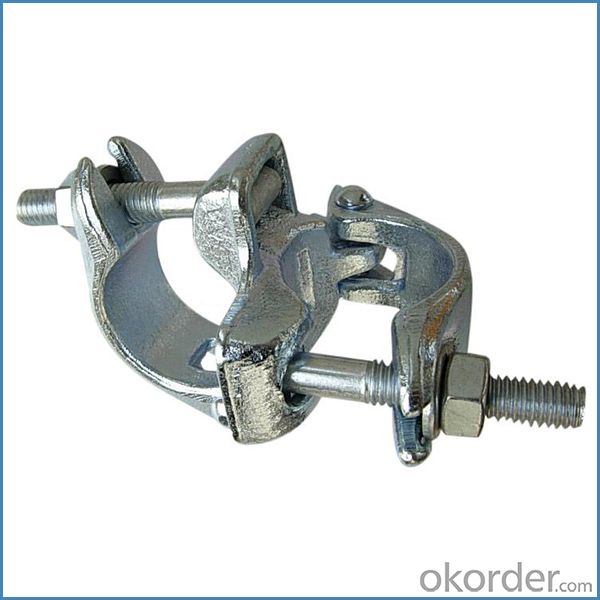
Parameter
| Material | Q235,345steel |
| Size | 48.3mm*48.3mm |
| Surface finish | Galvanized |
| Weight | 1.1kg around |
| Standard | BS1139,EN74 |
| Package | 25pcs/bag,steel pallet |
| Manufacture | As per customer requirement |
| Market | Africa, South America, the Middle East and Asia |
FAQ
Q: Are you a factory or trading company?
We are a state-owned corporation in China,dealing with various kinds of building materials.We have our holding subsidiaries.
Q: Where is your factory located? How can I visit there?
Our factory is located all around China.
Q: Can I get some samples?
Sample is free, customer only pay freight for the first time.
Q: Delivery?
10-30days. (5-15 containers)
Any question,feel free to contact us.
- Q: How do you ensure proper stability when using steel tube couplers in confined spaces scaffolding?
- To ensure proper stability in confined spaces scaffolding when using steel tube couplers, there are several measures that can be implemented: 1. Maintain adequate spacing: It is crucial to space the steel tube couplers evenly along the scaffolding structure. This will effectively distribute the load and prevent any weak points. 2. Ensure secure connections: Take care to properly tighten and secure the steel tube couplers to the scaffolding tubes. Loose connections can compromise stability and increase the likelihood of accidents. 3. Achieve proper alignment: Verify that the scaffolding tubes are correctly aligned and fully inserted into the steel tube couplers. Misalignment can result in weak connections and diminished stability. 4. Utilize diagonal bracing: Incorporate diagonal bracing within the scaffolding structure to enhance stability. These braces aid in evenly distributing the load and preventing excessive movement. 5. Conduct regular inspections: Regularly examine the steel tube couplers and scaffolding structure for any indications of damage or wear. Promptly replace any compromised or worn-out components to maintain stability and safety. 6. Ensure proper weight distribution: Avoid placing excessive weight on any particular section of the scaffolding. Distributing the load evenly across the structure prevents overloading and preserves stability. 7. Adhere to manufacturer guidelines: Always adhere to the instructions and guidelines provided by the manufacturer when working with steel tube couplers in confined spaces scaffolding. This ensures correct usage and maximizes stability. By adhering to these guidelines, one can ensure proper stability when utilizing steel tube couplers in confined spaces scaffolding, thereby minimizing the risk of accidents and creating a safe working environment.
- Q: What are the typical sizes and dimensions of steel tube couplers?
- Different applications and requirements necessitate a variety of sizes and dimensions for steel tube couplers. The sizes commonly range from 1 inch to 4 inches in diameter, with varying wall thicknesses depending on the desired load-bearing capacity. Typically, steel tube couplers have lengths ranging from 3 inches to 12 inches, and they feature threaded ends for easy connection and disconnection. The threads adhere to the National Pipe Thread (NPT) standards, ensuring compatibility with other pipe fittings. Apart from diameter and length, the overall dimensions of steel tube couplers can differ based on their specific design and purpose. Structural applications may call for larger and heavier couplers capable of handling heavier loads. Conversely, smaller and more compact couplers are suitable for plumbing or general piping applications. Ultimately, the size and dimensions of steel tube couplers are determined by the intended application, load requirements, and the type of pipes or tubes they are meant to connect. It is crucial to select the appropriate size and dimensions to ensure a secure and reliable connection, as well as compliance with industry or regulatory standards.
- Q: Can steel tube couplers be used in scaffolding projects with overhead structures?
- Indeed, steel tube couplers find application in scaffolding projects involving overhead structures. These couplers are frequently employed in scaffolding systems to join and fasten steel tubes, thereby establishing a secure and steadfast framework for workers to reach elevated zones. Constructed to endure substantial weight and offer a dependable link, these couplers prove apt for deployment in scaffolding projects integrated with overhead structures. Nevertheless, it remains imperative to ascertain the correct installation of couplers and ensure that the scaffolding system is devised and erected by proficient experts adhering to industry standards and safety regulations.
- Q: Can steel tube couplers be used in scaffolding projects with long spans?
- Yes, steel tube couplers can be used in scaffolding projects with long spans. Steel tube couplers are commonly used in scaffolding systems to connect steel tubes together, providing a secure and stable structure. They are designed to withstand heavy loads and provide a strong connection between tubes. When it comes to long spans in scaffolding projects, steel tube couplers are a reliable option. They can effectively connect the steel tubes across the span, ensuring the stability and safety of the scaffolding structure. However, it is important to consider the specific requirements of the project and consult with a structural engineer or scaffolding professional. They can assess the load capacity, span length, and other factors to determine the appropriate size and type of steel tube couplers to be used. It is crucial to ensure that the couplers are properly installed and meet the necessary safety standards to support the weight and span of the scaffolding. In summary, steel tube couplers can be used in scaffolding projects with long spans. They provide a secure and stable connection between steel tubes, ensuring the strength and stability of the scaffolding structure. However, it is important to consult with professionals and adhere to safety standards to ensure the proper installation and use of the couplers.
- Q: What are the common applications of steel tube couplers in scaffolding?
- Steel tube couplers are widely used in scaffolding for various applications. Some of the common applications of steel tube couplers in scaffolding are as follows: 1. Joining tubes: Steel tube couplers are primarily used to connect and join different lengths of steel tubes. They provide a strong and secure connection, ensuring the stability and safety of the scaffolding structure. 2. Creating scaffolding frames: Couplers are used to create scaffolding frames by connecting horizontal and vertical tubes. These frames provide a sturdy platform for workers to access elevated areas safely. 3. Forming bracing and diagonal supports: Steel tube couplers are also used to form bracing and diagonal supports in scaffolding structures. These supports help in distributing the load evenly across the scaffolding system and enhance its stability. 4. Securing scaffold boards: Couplers are used to secure scaffold boards in place, creating a stable working platform for workers. They prevent the boards from moving or slipping, reducing the risk of accidents or injuries. 5. Attaching accessories: Steel tube couplers can be used to attach various accessories to the scaffolding system, such as guardrails, toe boards, and safety nets. These accessories enhance the safety and functionality of the scaffolding structure. 6. Modular assembly: Steel tube couplers allow for modular assembly of scaffolding systems. This means that scaffolding structures can be easily assembled, disassembled, and reconfigured as per the specific requirements of a project. Couplers enable quick and efficient construction, saving time and labor costs. 7. Load distribution: Couplers play a crucial role in distributing the load across the scaffolding structure. They ensure that the weight is evenly distributed, preventing overloading and minimizing the risk of structural failure. 8. Versatility: Steel tube couplers are compatible with various sizes and types of steel tubes, offering versatility in scaffolding applications. They can be used with both standard and non-standard tube sizes, allowing for flexibility in scaffolding design and construction. In summary, steel tube couplers are essential components in scaffolding systems, used for joining tubes, creating frames, forming supports, securing scaffold boards, attaching accessories, enabling modular assembly, ensuring load distribution, and offering versatility. These applications contribute to the safety, stability, and efficiency of scaffolding structures.
- Q: Can steel tube couplers be used in scaffolding projects with restricted headroom?
- Yes, steel tube couplers can be used in scaffolding projects with restricted headroom. Steel tube couplers are versatile and can be used in various configurations to accommodate different project requirements. When working with restricted headroom, couplers can be used to create a compact scaffolding structure that can fit within the limited space available. By connecting steel tubes at various angles and directions, scaffolding can be constructed to reach the desired height while minimizing the space required. Steel tube couplers offer strong and secure connections, ensuring the safety and stability of the scaffolding structure even in challenging environments with restricted headroom.
- Q: Do steel tube couplers require any special maintenance or inspection?
- Yes, steel tube couplers do require special maintenance and inspection. Regular maintenance and inspection of steel tube couplers is necessary to ensure their proper functioning and to prevent any potential safety hazards. Regular maintenance includes routine cleaning and lubrication of the couplers to prevent rust and corrosion. This helps to ensure smooth operation of the couplers and extends their service life. It is also important to check for any signs of wear or damage, such as cracks, deformation, or excessive rusting, which may require immediate attention or replacement. In addition to routine maintenance, regular inspection is necessary to detect any potential issues or defects that may compromise the integrity of the couplers. Inspections should be carried out by trained professionals who can assess the condition of the couplers and identify any signs of wear, damage, or misalignment. This is particularly important in applications where the couplers are subjected to heavy loads or high vibrations, as these factors can increase the risk of failure. It is recommended to follow the manufacturer's guidelines for maintenance and inspection of steel tube couplers. These guidelines may include specific intervals for maintenance and inspection, as well as any recommended practices or tools for carrying out these tasks. By following these guidelines and conducting regular maintenance and inspections, the performance and lifespan of steel tube couplers can be optimized, ensuring safe and efficient operation.
- Q: Are steel tube couplers compatible with different scaffold system designs?
- Yes, steel tube couplers are compatible with different scaffold system designs. Steel tube couplers are versatile and can be used to connect tubes of various sizes and shapes together to form a scaffold structure. They are commonly used in construction and industrial applications and can be easily integrated into different scaffold system designs. The couplers provide a strong and secure connection between tubes, ensuring the stability and safety of the scaffold. Additionally, steel tube couplers are readily available and cost-effective, making them a popular choice in the scaffolding industry.
- Q: How do steel tube couplers contribute to the overall safety of scaffolding structures?
- The safety of scaffolding structures is enhanced by steel tube couplers in various ways. To begin with, these couplers create a secure and robust connection between different components of the scaffolding system. They are designed to fit tightly around the tubes, preventing any slipping or detachment during usage. As a result, the scaffolding structure remains stable and dependable, reducing the likelihood of accidents or collapses. Moreover, steel tube couplers aid in the equal distribution of weight and load across the scaffolding structure. By connecting the tubes at different points, they assist in transferring the weight and force exerted on the scaffolding to the ground, effectively minimizing the risk of overload or structural failure. This becomes particularly crucial when working at elevated heights or using heavy equipment and materials on the scaffolding. Furthermore, steel tube couplers are constructed from high-quality and durable materials that can withstand extreme weather conditions, corrosion, and other environmental factors. This ensures their resistance to wear and tear, guaranteeing the long-term stability and safety of the scaffolding structure. Additionally, steel tube couplers are designed for easy installation and removal, enabling quick and efficient assembly and disassembly of the scaffolding. This not only saves time and effort for workers but also reduces the chances of human error during the construction process, further enhancing the safety of the structure. In conclusion, steel tube couplers are essential in ensuring the overall safety of scaffolding structures by providing strong connections, even weight distribution, durability, and ease of use. Their incorporation in scaffolding systems helps minimize the risks associated with working at heights and ensures a secure and stable platform for workers to perform their tasks.
- Q: How do you dismantle scaffolding with steel tube couplers?
- To dismantle scaffolding with steel tube couplers, you should follow these steps: 1. Start by removing all planks and boards from the scaffold platform. 2. Unscrew and remove all diagonal and horizontal braces that connect the scaffold frames. 3. Loosen and disconnect the steel tube couplers using a wrench or scaffold spanner. 4. Carefully disassemble the scaffold frames by removing the vertical tubes one by one. 5. As you remove each tube, make sure to lower it safely to the ground to avoid any accidents. 6. Continue dismantling the frames until all tubes and couplers are removed. 7. Store the tubes and couplers in a safe and organized manner for future use or proper disposal. Remember to always follow safety guidelines and use appropriate personal protective equipment (PPE) when working with scaffolding. It is crucial to have a trained and experienced individual supervise the dismantling process to ensure it is done correctly and safely.
Send your message to us
Stainless Steel Coupler British Type for Sale
- Loading Port:
- Tianjin
- Payment Terms:
- TT OR LC
- Min Order Qty:
- 1000 kg
- Supply Capability:
- 100000 kg/month
OKorder Service Pledge
OKorder Financial Service
Similar products
Hot products
Hot Searches
Related keywords
